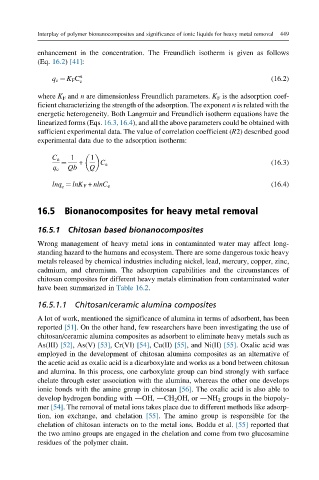Page 496 - Polymer-based Nanocomposites for Energy and Environmental Applications
P. 496
Interplay of polymer bionanocomposites and significance of ionic liquids for heavy metal removal 449
enhancement in the concentration. The Freundlich isotherm is given as follows
(Eq. 16.2) [41]:
q e ¼ K F C n (16.2)
e
where K F and n are dimensionless Freundlich parameters. K F is the adsorption coef-
ficient characterizing the strength of the adsorption. The exponent n is related with the
energetic heterogeneity. Both Langmuir and Freundlich isotherm equations have the
linearized forms (Eqs. 16.3, 16.4), and all the above parameters could be obtained with
sufficient experimental data. The value of correlation coefficient (R2) described good
experimental data due to the adsorption isotherm:
1
C e 1
¼ + C e (16.3)
q e Qb Q
lnq ¼ lnK F + nlnC e (16.4)
e
16.5 Bionanocomposites for heavy metal removal
16.5.1 Chitosan based bionanocomposites
Wrong management of heavy metal ions in contaminated water may affect long-
standing hazard to the humans and ecosystem. There are some dangerous toxic heavy
metals released by chemical industries including nickel, lead, mercury, copper, zinc,
cadmium, and chromium. The adsorption capabilities and the circumstances of
chitosan composites for different heavy metals elimination from contaminated water
have been summarized in Table 16.2.
16.5.1.1 Chitosan/ceramic alumina composites
A lot of work, mentioned the significance of alumina in terms of adsorbent, has been
reported [51]. On the other hand, few researchers have been investigating the use of
chitosan/ceramic alumina composites as adsorbent to eliminate heavy metals such as
As(III) [52], As(V) [53], Cr(VI) [54], Cu(II) [55], and Ni(II) [55]. Oxalic acid was
employed in the development of chitosan alumina composites as an alternative of
the acetic acid as oxalic acid is a dicarboxylate and works as a bond between chitosan
and alumina. In this process, one carboxylate group can bind strongly with surface
chelate through ester association with the alumina, whereas the other one develops
ionic bonds with the amine group in chitosan [56]. The oxalic acid is also able to
develop hydrogen bonding with dOH, dCH 2 OH, or dNH 2 groups in the biopoly-
mer [54]. The removal of metal ions takes place due to different methods like adsorp-
tion, ion exchange, and chelation [55]. The amino group is responsible for the
chelation of chitosan interacts on to the metal ions. Boddu et al. [55] reported that
the two amino groups are engaged in the chelation and come from two glucosamine
residues of the polymer chain.

